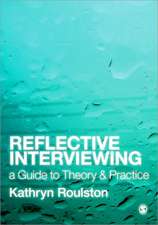Monte Carlo Simulation and Resampling Methods for Social Science
Autor Thomas M. Carsey, Jeffrey J. Hardenen Limba Engleză Paperback – 16 sep 2013
Preț: 554.68 lei
Preț vechi: 623.24 lei
-11% Nou
Puncte Express: 832
Preț estimativ în valută:
106.17€ • 115.36$ • 89.24£
106.17€ • 115.36$ • 89.24£
Carte disponibilă
Livrare economică 31 martie-14 aprilie
Livrare express 15-21 martie pentru 64.20 lei
Preluare comenzi: 021 569.72.76
Specificații
ISBN-13: 9781452288901
ISBN-10: 1452288909
Pagini: 304
Ilustrații: illustrations
Dimensiuni: 187 x 232 x 20 mm
Greutate: 0.52 kg
Ediția:First Edition
Editura: SAGE Publications
Colecția Sage Publications, Inc
Locul publicării:Thousand Oaks, United States
ISBN-10: 1452288909
Pagini: 304
Ilustrații: illustrations
Dimensiuni: 187 x 232 x 20 mm
Greutate: 0.52 kg
Ediția:First Edition
Editura: SAGE Publications
Colecția Sage Publications, Inc
Locul publicării:Thousand Oaks, United States
Recenzii
There is no text like this that is geared toward a social science market.
[The] writing is direct and to the point... I can’t underemphasize that part. Too many methods books try to soften the technical edge by throwing in lots of commentary.
Bradley Efron discussed the newly-invented bootstrap and other computationally intensive statistical techniques in a 1979 article entitled "Computers and the Theory of Statistics: Thinking the Unthinkable." But as computer power grew exponentially and software for simulation greatly improved, what was once unthinkable has become routine. Carsey and Harden have performed a service by making modern tools for random simulation and resampling methods (like the bootstrap) accessible to a broad readership in the social sciences, developing these methods from first principles, and showing how they can be applied both to understand statistical ideas and in practical data analysis.
Statistical simulation has become an essential tool of modern statistics and data analysis—useful for evaluating estimators, calculating features of probability distributions, transforming difficult-to-interpret statistical results into meaningful quantities of interest, and even helping with alternative theories of inference. Simulation perspectives also offer a terrific way to learn many aspects of statistical modeling. Join Tom Carsey and Jeff Harden for a clearly written and deeply practical book on this crucial topic. Your scholarly work will be better for it.
Carsey and Harden have written an intuitive and practical primer to a radical—but increasingly widely used—approach to statistical inference: Monte Carlo and resampling. They focus on using these techniques to evaluate more standard statistical approaches, but in the process, they convey their broader use and importance. They also teach the reader about statistical inference at a much more basic level than do most social science treatments of empirical methods. Their book is destined to be used widely in graduate social science statistics classes around the world.
Monte Carlo simulation and resampling are the workhorse of modern methods. Carsey and Harden provide the perfect, accessible guide to learn this fundamental, must-have skill for social scientists.
[The] writing is direct and to the point... I can’t underemphasize that part. Too many methods books try to soften the technical edge by throwing in lots of commentary.
Bradley Efron discussed the newly-invented bootstrap and other computationally intensive statistical techniques in a 1979 article entitled "Computers and the Theory of Statistics: Thinking the Unthinkable." But as computer power grew exponentially and software for simulation greatly improved, what was once unthinkable has become routine. Carsey and Harden have performed a service by making modern tools for random simulation and resampling methods (like the bootstrap) accessible to a broad readership in the social sciences, developing these methods from first principles, and showing how they can be applied both to understand statistical ideas and in practical data analysis.
Statistical simulation has become an essential tool of modern statistics and data analysis—useful for evaluating estimators, calculating features of probability distributions, transforming difficult-to-interpret statistical results into meaningful quantities of interest, and even helping with alternative theories of inference. Simulation perspectives also offer a terrific way to learn many aspects of statistical modeling. Join Tom Carsey and Jeff Harden for a clearly written and deeply practical book on this crucial topic. Your scholarly work will be better for it.
Carsey and Harden have written an intuitive and practical primer to a radical—but increasingly widely used—approach to statistical inference: Monte Carlo and resampling. They focus on using these techniques to evaluate more standard statistical approaches, but in the process, they convey their broader use and importance. They also teach the reader about statistical inference at a much more basic level than do most social science treatments of empirical methods. Their book is destined to be used widely in graduate social science statistics classes around the world.
Monte Carlo simulation and resampling are the workhorse of modern methods. Carsey and Harden provide the perfect, accessible guide to learn this fundamental, must-have skill for social scientists.
Cuprins
1. Introduction
2. Probability
3. Introduction to R
4. Random Number Generation
5 .Statistical Simulation of the Linear Model
6. Simulating Generalized Linear Models
7. Testing Theory Using Simulation
8. Resampling Methods
9. Other Simulation-Based Methods
10. Final Thoughts
2. Probability
3. Introduction to R
4. Random Number Generation
5 .Statistical Simulation of the Linear Model
6. Simulating Generalized Linear Models
7. Testing Theory Using Simulation
8. Resampling Methods
9. Other Simulation-Based Methods
10. Final Thoughts
Notă biografică
Descriere
Taking the topics of a quantitative methodology course and illustrating them through Monte Carlo simulation, this book illustrates abstract principles, such as bias, efficiency, and measures of uncertainty in an intuitive, visual way.






